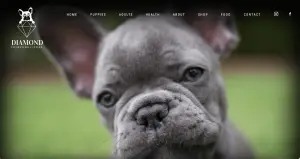The 411 on Hip Dysplasia in French Bulldogs
When you own a French Bulldog, there are many things you are warned to be on the lookout for and one of those is hip dysplasia. Most people think of dysplasia being a problem for large breed dogs, but it is something that can happen to any breed. In fact, with bulldogs, it is often a genetic issue or due to obesity. The best way to handle French Bulldog hip dysplasia is to go into ownership knowing as much about the condition as possible.
What is Hip Dysplasia?
Just like in humans, the hip is comprised of a bone with a ball end fitting nicely into another bone (the hip) with a socket. Ball and socket joints that do not fit properly are said to have dysplasia. The bones will grind together instead of sliding around smoothly. Overtime, the bones begin to deteriorate and lead to loss of function and pain.
Potential Causes Of Hip Dysplasia
While the primary cause of French Bulldog hip problems is genetic predisposition, there are several other factors to consider. With French Bulldogs especially, you will want to make sure you manage their weight and feed them proper nutrition to make sure you do not add stress to the joints. Finally, if you notice your dog is growing quickly, you will want to talk to your veterinarian to discover how to keep your pup healthy and watch for any joint issues.
Hip Dysplasia Prevention
In most dogs, dysplasia is a preventable disorder, and not breeding dogs that have genetic history of the disorder is the first step. If you know that your dog has dysplasia in the family history, your veterinarian will want to put you on a diet that is specially formulated to help joint health. In addition to a special diet, many vets will want you to add a glucosamine and chondroitin supplement. This supplement is very good for older dogs to help with joint health, but can be given to dogs of any age. Finally, your dog’s weight is a huge factor in preventing hip dysplasia. Obesity adds a lot of unnecessary stress to joints, but you need to make sure you do not overwork your dog’s joints as well. The best preventative care for Frenchies includes making sure they do not take part in activities that require excessive jumping, playing on hard turfs, or make quick turns. Their smaller stature cannot sustain the activities without causing damage.
French Bulldog Hip Dysplasia Symptoms
Before discussing the symptoms of hip dysplasia, it is very important to note that they mimic arthritis in dogs. Just because you see the symptoms listed, it does not imply that your dog automatically is battling from hip dysplasia. You will want to make sure you talk to a veterinarian for further tests and especially with French Bulldogs, you will want to seek second opinions. French Bulldog hip problems are common, but generally not due to dysplasia. Dogs that battle hip dysplasia will be in obvious pain and avoid activities that require them to use their hindquarters, including climbing stairs and running. With French Bulldog back leg problems, you will notice a decrease in overall activity and a lameness when they walk. When you touch the hip area, you should feel a grinding as the ball moves through the socket and overtime, a visible reduction in muscle mass.
Here are some potential French Bulldog Hip Dysplasia signs to look Out for:
- Decreased activity of your French Bulldog
- Difficulty or reluctance rising, jumping, running, or climbing stairs
- You might notice a decrease in range of motion of your dogs hip joints
- General lameness in your Frenchie’s hind end
- Altered gait / altered walking. You may notice a swaying or “bunny hopping” movement pattern
- Crepitus or a grinding in the joint during movement
- Decrease of thigh and possibly hamstring muscle mass
- Increase in the shoulder muscles as your French Bulldog attempts to compensate for the hind end weakness
- Noticeable Pain
- General stiffness
Diagnosing Hip Dysplasia
Diagnosing hip dysplasia is not one of the easier disorders to pinpoint because it can be many other problems. If you notice lameness or stiffness in your dog, you will want to talk to your veterinarian at check-ups. Veterinarians will first manipulate the joint to see the range of motion and feel for any grinding. However, they will also want to run blood tests and have a scan of the joint done. Blood tests will make sure that your dog does not have an infection in their body that is causing swelling and lameness. The radiology scans let the veterinarian know if there is a different injury, such as a tear in the ligament which is common for French Bulldogs). If the French Bulldog back leg problems are determined to be hip dysplasia, the x-ray will let the doctor know the severity and what treatment option will be best for your pup.
French Bulldog Hip Dysplasia Treatment Options
Prior to surgery, veterinarians will want to try other treatment options for your dog. Surgery for dysplasia is not financially possible for some, and may not be necessary for others. If you are in the beginning stages of dysplasia, it is possible that exercise reduction and physical therapy will prevent fast deterioration. Veterinarians will also want to add in anti-inflammatory and other joint supplements that will help reduce the swelling in the area and help the joint move as designed. Finally, there are regenerative treatments available for dogs. Stem cell therapy and cold laser therapy as both ways to control pain, treat inflammation, and help heal naturally. However, they are both often a lot more costly than surgery.
Unfortunately, occasionally surgery is the only option available to rectify hip dysplasia. Prior to surgery, you will want to research which strategy will be best for your dog. There are three options available at this time for hip dysplasia.
DPO/TPO – Double or Triple Pelvic Osteotomy
Double or triple pelvic osteotomy is the option that many veterinarians select if the dog suffering from hip dysplasia is under ten months of age. The pelvic bone is selectively cut in a way that the entire function of the joint is improved. This is more commonly seen in large breed dogs that have family history of dysplasia.
FHO – Demoral Head Ostectomy
Femoral head ostectomy is another surgery that does not create a hip function that is considered normal, but it is less expensive and offers successful pain management. It is performed on all ages of dogs and is where the veterinarian will create a false joint by removing the head of the femur.
THR – Total Hip Replacement
If you are looking for a long-term solution to French Bulldog hip dysplasia, then you will want to talk to the veterinarian about Total Hip Replacement. This surgery removes your dog’s joint and replaces it with implants made of metal and plastic. It allows for a completely normal use of the joint and most discomfort is removed. However, it is important to know that this surgery will require a lot more recovery time than the other two types of surgery.
Overall Prognosis – French Bulldog Hip Dysplasia
Hearing that your dog has hip dysplasia often leads to stress and fear of the unknown. Dogs that battle this disorder do have the ability to live long, healthy lives. With preventative care, you can help catch the disorder quickly and use lifestyle changes to delay any need of surgery. However, if surgery does end up being a need, veterinarians will help you change your dog’s diet and receive follow-up care to get your dog back to his or her normal routine and living life to the fullest.
For more French Bulldog health information click here.
For more information on dog leg injuries check this out.



